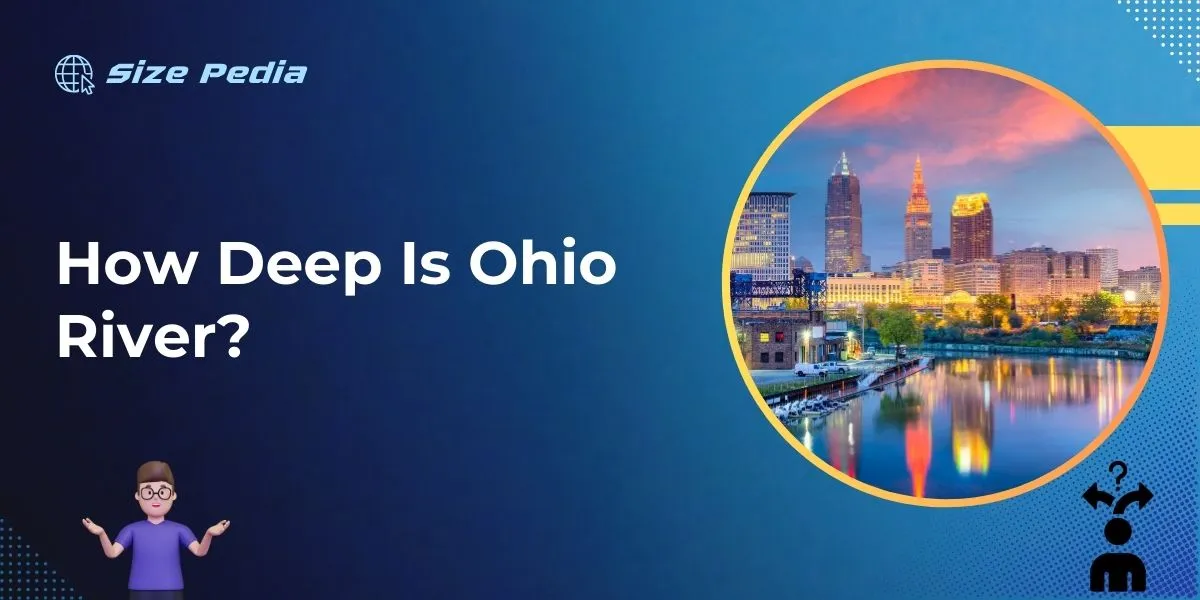The Ohio River has an average depth of about 24 feet. Its deepest point can reach up to 168 feet.
The Ohio River stands as an iconic waterway in the United States, boasting a mix of historical significance and modern utility.
Spanning over 981 miles, this mighty river serves as a natural border for states like Illinois, Indiana, and Ohio, before eventually merging with the Mississippi River.
It’s a crucial conduit for economic activity, supporting industries through shipping and transportation. The river’s diverse ecosystems provide a habitat for numerous wildlife species. As a recreational hotspot, it attracts fishing enthusiasts, boaters, and nature lovers alike.
The Ohio River’s depth varies considerably, influenced by rainfall, dam controls, and location, ensuring its role as a dynamic feature of the American landscape.

Probing The Ohio River
Probing the Ohio River unveils a world where water depth is more than just a number. It’s a tale of history, nature, and the twists and turns of this vital waterway.
The Ohio River’s depths hold secrets to its power and influence across states. Embark on a journey to uncover the stories beneath the surface of one of America’s great rivers.
The Source And Journey
The Ohio River begins its story in Pittsburgh, Pennsylvania. Two rivers, the Allegheny and Monongahela, meet here to form the Ohio. From its birthplace, the river travels about 981 miles.
It flows through or borders six states. West Virginia, Ohio, Kentucky, Indiana, and Illinois all share its waters. The river finally surrenders to the mighty Mississippi in Cairo, Illinois. Along its course, the Ohio River nourishes a broad expanse of America’s heartland.
- Pittsburgh, Pennsylvania: The starting point
- 981 miles long: The river’s impressive journey
- Six states: A link that binds multiple regions
- Mississippi River: The Ohio’s ultimate destination
Factors Affecting River Depth
The depth of the Ohio River is a dynamic feature. It changes with various factors playing their part. Seasonal rainfall and snowmelt can cause depths to fluctuate. Man-made structures, like dams and locks, also influence the water levels.
Natural events such as droughts or floods contribute to these variations too. Depth measurements can range from as little as 3 feet in some places to over 100 feet in others.
| Factor | Impact on Depth |
| Rainfall & Snowmelt | Increases |
| Dams & Locks | Regulates |
| Natural Events | Varies |
Understanding these factors empowers us to appreciate the river’s behavior. It’s a reminder of nature’s constant state of change, flowing just like the waters of the Ohio River.
Measuring The Depths of Ohio River

The Ohio River’s depth is not just a number. It tells a story of geography, climate, and human intervention.
Exploring the depths of the Ohio River reveals fascinating insights about the waterway that has been pivotal to transportation and commerce throughout American history.
Historical Depth Records
History charts the river’s past. Records from the 19th and early 20th centuries provide a glimpse into the Ohio River’s historical depth.
- Steamboat navigators were among the first to measure.
- Early measurements were crucial for safe passage.
- Charts show variation over years due to natural changes.
Data collected over time indicates fluctuations. Seasonal rains and droughts often impacted depth. This created challenges for those relying on the river for transport.
Modern Measurement Techniques
Today, depth measurement is more accurate and consistent.
- Sonar technology bounces sound waves off the riverbed.
- GPS systems ensure precise location tracking.
- Satellites provide data for large-scale mapping projects.
Modern tools have revolutionized understanding of the river’s depths. These innovations enable continuous monitoring, crucial for navigation, ecological research, and flood management.
| Century | Average Depth (Feet) | Data Collection Method |
| 19th | 20 | Manual Measurement |
| 21st | 24 | Sonar and GPS Technology |
Variations In Depth
Exploring the Ohio River reveals a dynamic environment. Its depth is not constant but changes, offering unique challenges and opportunities.
From recreational boating to commercial navigation, the variations in depth play a critical role. Let’s dive into these changes and understand how they affect the river.
Seasonal Fluctuations
The Ohio River’s depth changes with the seasons. During spring, melting snow and rain contribute to higher water levels. This seasonal shift can significantly increase the river’s depth, which often accommodates larger vessels.
In contrast, summer brings drier conditions. Water levels recede and so does the river’s depth. Fall usually mirrors summer conditions, but winter can either show a decrease due to ice formation or a spike from rain and snowmelt.
Geographical Differences
The Ohio River’s journey spans several states, meaning its depth is not uniform. Near its origin in Pittsburgh, the river is shallower. As it winds down through various landscapes, deep channels and shallow banks alternate.
Deeper sections occur in places where the river widens or where human intervention has dredged the riverbed. Vessels use these areas to navigate safely. Shallower parts are often found upstream where sediment builds up or geography narrows the river.
| Location | Average Depth (feet) |
| Pittsburgh, PA | 12 |
| Cincinnati, OH | 20 |
| Louisville, KY | 23 |
| Cairo, IL | 50 |
The table shows general depth measurements at key locations. Note that these figures can vary due to the factors discussed above.
The Deepest Points
The Ohio River boasts a journey through history and nature, inviting awe with its vast stretches. Within its winding path, certain spots plunge deeper than the rest, hiding secrets in their depths.
Let’s dive into the deepest points of this majestic river and uncover what lies beneath its flowing veil.
Known Deep Spots
The Ohio River, a lifeline for many communities, holds areas where the depth is surprisingly greater than the average 24 feet. These deep spots fascinate explorers and locals alike. Some of the most notable deep points are:
- Cannelton Locks and Dam: Depths can soar to around 85 feet.
- McAlpine Locks and Dam: A region where the river reaches up to 90 feet.
- Markland Locks and Dam: Depths have been measured at over 70 feet.
Exploring The Riverbed
Behind these numbers lies an underwater landscape ripe for exploration. Sonar and diving expeditions reveal a world of historical artifacts, geological formations, and aquatic life. Consider these highlights:
| Feature | Description |
| Sunken Vessels | From steamboats to barges, the depths harbor past maritime tales. |
| Rock Structures | Rocky outcrops and ledges form the riverbed’s complex topography. |
| Wildlife Habitats | Catfish and freshwater mussels thrive in the deeper, quieter waters. |
Navigating The Waters In Ohio River

The Ohio River presents an intriguing journey for those on its waters. Its depth varies, creating unique challenges and opportunities for transportation and recreational activities.
The river’s depth can influence how we travel, the cargo we carry, and the joys we find in boating adventures. Let’s delve into how the Ohio River’s depth plays a pivotal role in navigating its waters.
Impact On Transportation
The Ohio River’s depth affects transport significantly. This waterway serves as a critical channel for moving goods across the United States. A range of vessels use the river, from small boats to large barges.
- Commercial barges depend on the river for shipping commodities.
- Consistent water levels are key for smooth transit.
- Locks and dams help maintain navigable depths.
| Depth Range (feet) | Vessel Type |
| 9-12 | Recreational Boats |
| 12+ | Commercial Barges |
Safety Measures For Boaters
Safety is vital for those navigating the Ohio River. The varying depths across different river segments demand smart and cautious boating.
- Always wear a life jacket.
- Know the river’s current depth before setting out.
- Use a depth finder to avoid shallow areas.
- Stay updated on weather changes.
- Understand the navigation rules and signals.
By recognizing the importance of the Ohio River’s depth, we ensure not only the efficiency of transport but also the safety and enjoyment of everyone on the water.
Conservation Efforts
The Ohio River is a precious natural resource that demands careful attention and protection.
Conservation efforts are vital for preserving this waterway’s depth and diverse aquatic life. Such initiatives ensure the Ohio River can be enjoyed for generations to come.
Maintaining Water Levels
Consistent water levels are crucial for a healthy Ohio River. Erosion and drought can lower water depths, impacting local communities and wildlife. Conservationists work tirelessly to monitor and manage these levels. They use strategies like:
- Dam operations to control flow
- Watershed management to prevent pollution
- Conservation releases during dry periods
Protecting River Ecosystems
The river’s ecosystem is home to many species. Protecting habitats promotes biodiversity. Efforts include:
- Restocking fish populations for ecological balance
- Removing invasive species that threaten native life
- Educational programs to raise awareness
By supporting such measures, we can ensure the Ohio River’s ecosystems remain vibrant and resilient.
FAQs About How Deep Is Ohio River
What Is The Maximum Depth Of The Ohio River?
The Ohio River’s maximum depth reaches approximately 85 feet near Louisville, Kentucky. This deep section allows for significant commercial and recreational navigation.
How Deep Is The Ohio River On Average?
On average, the Ohio River has a depth of about 24 feet, though this can vary significantly depending on the specific location and seasonal changes such as rainfall.
Where Is The Ohio River Deepest?
The deepest point of the Ohio River is near Louisville, Kentucky, where it reaches depths of up to 85 feet. This makes it a key navigation route for larger vessels.
Does The Ohio River’s Depth Fluctuate Seasonally?
Yes, the depth of the Ohio River fluctuates seasonally. Spring rains and melting snow can significantly increase its depth, while drought conditions may lead to lower water levels.
Conclusion
Exploring the depths of the Ohio River reveals a storied past beneath its waves. Stretching from Pittsburgh to Cairo, this waterway has an average depth of about 24 feet. Yet, its deepest point near Louisville plunges to over 130 feet.
Remember, this river’s dynamic ecosystem is as vast as its rich history. Embrace the Ohio River’s depths, whether for academic curiosity or the thrill of exploration.
Resources:
1. https://www.nps.gov/articles/the-ohio-river.htm
